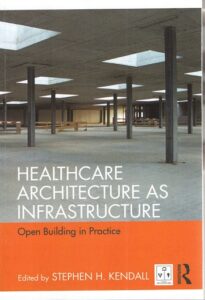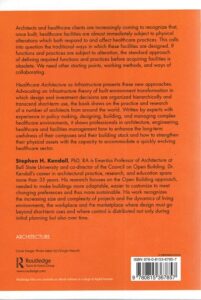Healthcare Architecture as Infrastructure: Open Building In Practice
Edited By: Stephen H. Kendall
About The Authors
Stephen H. Kendall, PhD, RA is Emeritus Professor of Architecture at Ball state University and co-director of the Council on Open Building. Dr Kendall’s career in architectural practice, research, and education spans more than 35 years. His research focuses on the Open Building approach, needed to make buildings more adaptable, easier to customize to meet changing preferences and thus more sustainable. His work recognizes the increasing size and complexity of projects and the dynamics of living environments, the workplace, and the marketplace where design must go beyond short term uses and where control is distributed not only during initial planning but also over time.
About The Book
Architects and healthcare clients are increasingly coming to recognize that once built, healthcare facilities are almost immediately subject to physical alterations which both respond to and affect healthcare practices. This calls into question the traditional ways in which these facilities are designed. If functions and practices are subject to alteration, the standard approach of defining required functions and practices before acquiring facilities is obsolete. We need other starting points, working methods, and ways of collaborating.
Healthcare Architecture as Infrastructure presents these new approaches. Advocating an infrastructure theory of built environment transformation in which design and investment decisions are organized hierarchically and transcend short-term use, the book draws on practice and research of a number of architects from around the world. Written by experts with experience in policy making, designing, building, and managing complex healthcare environments, it shows professionals in architecture, engineering, healthcare and facilities management how to enhance the long-term usefulness of their campuses and their building stock and how to strengthen their physical assets with the capacity to accommodate a quickly evolving healthcare sector.
“We should not try to forecast what will happen, but try to make provisions for what cannot be foreseen.”
John Habraken
Dedicated to John Habraken, mentor and friend, whose body of work over more than 50 years has helped lead to a deeper understanding of change and the distribution of control in the making of the built environment, and who has pioneered the development of architectural design methods needed to cultivate the built field in all its wonder and complexity.
Introduction
Healthcare architecture planned for change is the main theme of the essays collected here. The books broader proposition is, however, that the architecture of today’s and tomorrow’s building stock can and should inspire, be prepared for and open to developments not imaginable in a specific moment. That encompasses all project types – housing, educational and healthcare facilities, places of work and commerce.
The chapters, in diverse fashion, touch on two assumptions about how healthcare facilities – and the built environment more broadly – come into being and transform: 1) the acquisition of buildings and building complexes – to be resilient, culturally grounded and prepared for change – must recognize the distribution rather than unification of decision-making control, initially and over time, and 2) new design skills are needed, suited to this reality, to assure excellence and readiness for change in both architectural and urban design.
There can really be no question that buildings and built environment that remain vital, coherent and resilient transform part-by-part, not once, but over and over. This is a long view, an admittedly elusive view in cultures in a rush. Too often, we architects fall into the trap of thinking that once a project is “done” under our watch, that it will never change again. Certainly this ideology is at the centre of architectural education worldwide, thus planting seeds that must be overcome in practice, without much of a supportive theoretical or methodological discourse. This short-sighted perspective serves no-one and certainly not the sustainability and coherence of built environment as such and certainly doesn’t correspond with reality. After all, we are often called back to change a building we designed earlier, but more frequently we add to or modify a building designed by someone else. Our practices depend on it.
How are we doing this work? What attitudes – and policies – are needed as we rethink our endeavours? How are our skills adjusting to this more dynamic and long-term way of seeing architecture and urban design? How do we “hand-off” a project to other architects who follow us in cultivating a particular building site? Will “big data” help as we employ simulation tools to support multi-disciplined decision-making? How will increased computational power assist distributed control? What can history teach us? Are we producing coherence with variety, or simply confusion, conflict and waste?
My hope is that readers of these chapters will come away sharing the recognition that we are in a hopeful transition phase in learning the skills needed to steer incremental change in the built environment – at whatever level we are working. The “we” I refer to includes the design professions, regulatory / policy-making sector. This transition is not smooth, but is inevitable. The rough sailing should not be particularly surprising given the fact that decision-making is increasingly dispersed and unfolds over time, that building users are increasingly individualized, and that our technical repertoire and technical mastery have expanded with incredible rapidity in the last 50 years. Apart from important questions on matters of style or architectural quality, this is confusing and contentious – and often litigious – time in the building and real property industries. New players enter the stage and frequently display the hubris of believing that they can remake the stage itself with little or no deep understanding of what happened before or without sending out thought probes into the future. It is as if the breathless rush of invention and innovation, rather than cultivation, was the key to success. Aversion to risk and new approaches are high, and yet at the same time pressures are strong to find better ways of building and managing divided control of complex real property assets over time.
While planning our building stock for constant adjustment and transformation is not a settled process, there are signs of hopeful new approaches that do in fact suggest effective departures from past methods – and the belief systems that gave rise to those methods. In selecting authors to contribute to this book, I found myself asking why we should expect the process of built environment transformation to be less riddled with conflict, waste, and disruption than it is. Perhaps expecting otherwise is naïve, given how multi-faceted and never-ending the process is, how rapidly standards of building performance change, how quickly user preferences shift, and recognizing how deeply entangled decision-making is among parties with competing and conflicting interests.
Naïve or not, such a vision of doing a better job drives those whose work is collected in this book. Their voices are varied, and are not alone. Their work is mirrored by many other building professionals, researchers, and managers around the world (for example: Capolongo, 2012) who haven’t capitulated to cynicism or ignorance, but who work with their feet on the ground and their minds in constant learning mode. We should hope for a sustainable and resilient building stock less burdened by incessant and tiresome conflict and difficulty. This requires us to develop new methods to make building stock transformation effective, equitable, and conventional in practice – as well as producing excellent if not delightful architecture. In moving towards this goal, we need to work very hard to recreate the knowledge that has undergirded built environments around the world that have sustained themselves for hundreds of years, and adjust and augment that knowledge so that it is compatible with contemporary realities. The authors in this collection are part of this search.
While technical issues are discussed in these chapters, the core challenges, not surprisingly, are essentially non-technical. They reside in the ecology of decision-making and in changing minds. Moving beyond detailed programming and fixed floor plans as a necessary precursor of designing and procuring complex buildings is clearly not easy for clients, users, financial institutions, regulators, or design service providers who seek certainty and to avoid risk. So what comes first: changing skills (habits) or changing minds? Is it worthwhile learning new skills and attitudes if those who need them and must eventually demand them have not changed their minds? My experience in teaching architecture students is that it is not difficult to teach new skills associated with the Open Building approach. But what good is it if an architect has shifted attitudes and has learned a new set of design skills if their client has not recognized the need to ask for them? Then what? What is the dance that designers engage in with the actors that they exist to serve? Between the lines, and sometimes explicitly, the chapters in this book hint at these questions and the problem of changing attitudes and minds – our own and others. There is a very large and deep literature on changing minds – see, for example, Howard Gardner’s writings (2006) or that of Adam Grant (2016), but too little of this work focuses on the field we operate in – the built environment.
Functions (healthcare and otherwise) and practices are changing, and we really should stop scraping buildings and neighbourhoods and rebuilding them anew from scratch at the current feverish and wasteful pace. We need other starting points, other working methods, other ways of collaborating, and other ways of seeing architecture, ways that recognize continuous cultivation as a value. Perhaps the needed transition is happening because reality is drawing us there. The book’s title suggests that an infrastructure model of built facilities makes sense as a guiding principle in the design of healthcare facilities – and other project types as well. This is implicit in the recognition by both clients and the architecture/engineering communities that once built, healthcare facilities are almost immediately subject to physical alterations, at several levels, that respond to – and also have an impact on – medical practices, human wellbeing, governmental policies, and professional techniques. Changes both large-scope and fine grained occur even before the construction of the new buildings is completed, and often occur during the design process, not to mention the time axis well into the future. The infrastructure model for buildings helps clarify how to manage these complex systems. This perspective is further developed in Chapter 1 and those that follow.
References
Cappolongo,S (2012). Architecture for Flexibility in Healthcare. Milano, Italy: FrancoAgnelli s.r.l.
Gardner H (2006) Changing Minds – The Art and Science of Changing Our Own and Other People’s Minds. Cambridge: Harvard Business School Press
Grant, A (2016) – How Non-Conformists Move the World. New York: Viking – Imprint of Penguin-Random House


2 thoughts on “Healthcare Architecture as Infrastructure: Open Building In Practice”